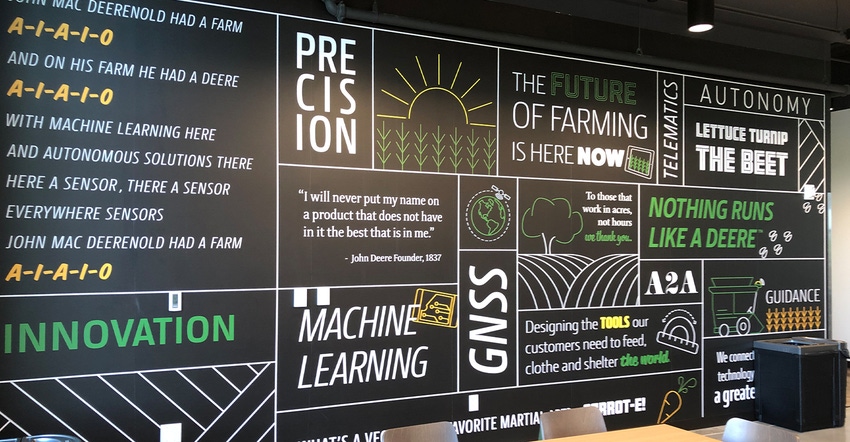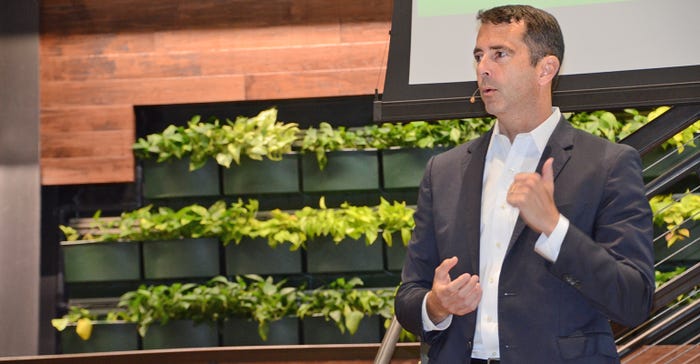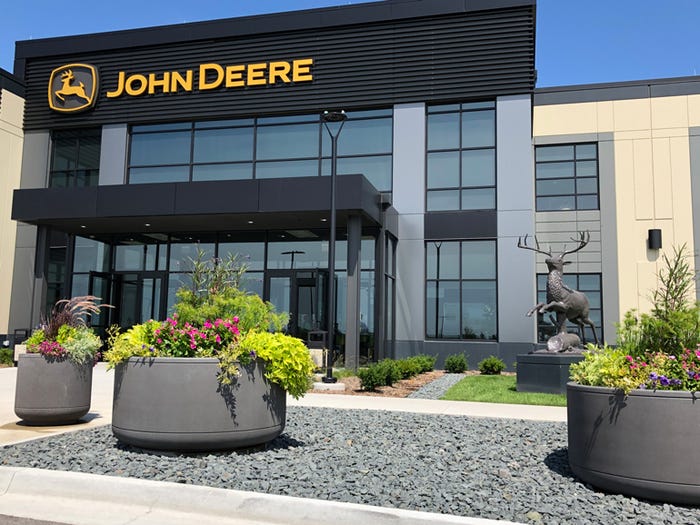September 5, 2019

Agriculture is a disrupted market. The new forces in play for farmers and the companies that serve them are changing the rules.
From lack of labor to more intense weather extremes worldwide, the work of producing food isn’t getting any easier. Add in a growing population challenge, and the work ahead will require application of new technologies and a creative mindset beyond the status quo of just a few years ago.
That’s the challenge John Deere faces as an innovator in the equipment space — but one the company isn’t afraid to embrace. “We’ve been a leader in technology and innovation and disruption for our entire history,” says John Stone, senior vice president, John Deere Intelligent Solutions Group. “At the turn of the 20th century, in 1918, we made a major investment in the internal combustion engine and disrupted ourselves, because until then we were a plow company.”

LEADING THE CHARGE: John Stone, senior vice president, John Deere Intelligent Solutions Group, heads a group of 2,000, with a focus on producing next-generation tools that continue the work of boosting on-farm productivity in a changing environment. More than 800 are now working in a new facility in Johnston, Iowa.

That Waterloo Boy purchase more than 100 years ago turned the company in a new direction. And just over 25 years ago, the company made another turn toward precision agriculture: What started as the Precision Farming Group has evolved into the Intelligent Solutions Group, given the changing nature of farm technology. “A short 81 years later, we made another breakthrough with our investment in GPS that led to the creation of the AutoTrac system that automated the job of driving the tractor,” Stone explains.
Stone shared those thoughts during a special media unveiling of the company’s new headquarters for its Intelligent Solutions Group in Johnston, Iowa. The needs of agriculture are changing, and Stone explains that the company sees the opportunity and the challenges ahead.

PAST, PRESENT, FUTURE: This feature wall in the game room (yes, game room) at John Deere ISG has a range of interesting features, from the exact GPS location of the facility (left) to that historic deer head that has been around for more than 100 years.

A new kind of workspace
Visitors walking into the ISG facility get a different feeling than during visits to other John Deere facilities. Perhaps it’s the restored John Deere sign from a Maryland dealership — or the large open atrium, with an upper level of restaurant-type booths where people can meet. There’s a major sense of collaboration in this facility, where a wide range of varied disciplines comes together to create the tech and machines of the future.
What John Deere has created looks more like a visit to Google than a jaunt to the engineering center for a leader in farm equipment. And that’s part of the nature of this changing business, Stone explains. It’s becoming more important on a global basis as new technologies come on line.
He points to the company’s acquisition of Blue River, creator of See and Spray technology. As Stone says, it is technology that provides a “smart spraying system that can look at a field, and understand that this green, leafy plant is a crop that needs me to take care of it; and that green leafy plant beside it is a weed and needs to be killed.”
He adds that by Deere’s test results, that system can reduce herbicide use by up to 80%. “Think about the power of that reduction,” Stone adds.
Deere’s ISG group has 2,000 employees worldwide, with 830 headquartered at this new facility. This group includes engineering disciplines, software designers, robotics experts, computer vision people and those involved with machine learning — and there’s a heavy investment in mechatronics, the merger of mechanical and electronic systems.

NEW SPACE: The new headquarters for the John Deere Intelligent Solutions Group has a futuristic feel, but that leaping deer statue in the foreground links to company history. It’s one of only 14 known versions of the company symbol worldwide.

Meeting a changing design culture
The space itself features what Stone calls a frugal design, with fewer walls and more open spaces. Fewer walls cuts manufacturing costs, and many of the walls a visitor might see are temporary or movable to create new spaces as needed. The open design offers a more collaborative place, where engineers and software designers can come together formally or informally to meet and discuss new approaches.
That wasn’t possible in the old spaces, which in some cases were spread between two buildings. So, a software engineer might be in a space a half-mile from the systems engineer who needed to discuss a sensor package. Today, they can walk a few steps and meet in a common space to talk. That’s critical, because the machines of today include a lot more than iron. The vision systems and sensors deployed in new equipment help improve efficiency, reduce downtime and boost overall productivity.
In addition, the new building has casual spaces and a more casual dress code (jeans are acceptable all week long). There’s a game room, where employees can play foosball or pingpong and push off stress. During a tour, visitors were told that some employees stay after hours to enjoy that social time.
The next-generation designers coming into new jobs these days have different work environment requirements. Combine that with changing technology that also alters the design process, and the new ISG facility John Deere has built is structured to leverage this new innovation culture. Farmers will see that in new tools heading to market in the future.
About the Author(s)
You May Also Like






